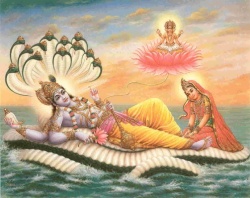Vishnu
Vishnu (Sanskrit: विष्णु) is a Vedic Supreme God (including his different avatars) in Hinduism, and is venerated as the Supreme Being in Vaishnavism. Vishnu is also known as Narayana and Hari (See Keshava Namas) and is venerated as Purushottama or Supreme Purusha in Vedic sacred texts like the Bhagavad Gita, the Vedas and the Puranas. He is the Supreme Purusha of Purusha Sukta. The Vishnu Sahasranama, (the thousand names of Vishnu) of the Mahabharata declares Vishnu as Paramatman (supreme soul) and Parameshwara (supreme God). It describes Vishnu as the all-pervading essence of all beings, the master of—and beyond—the past, present and future, the creator and destroyer of all existences, one who supports, sustains and governs the universe and originates and develops all elements within.
Vaishnavism sees Vishnu as the Supreme God, and venerates him as the Supreme Being. Smarta followers of Adi Shankara, among others, venerate Vishnu as just one of the five primary forms of God, namely Shiva, Vishnu, Devi, Surya and Ganesha; who are all seen as equal reflections of the one Brahman, rather than as distinct beings. His supreme status is declared in Hindu sacred texts; the Vedas the Bhagavad Gita, the Bhagavata Purana and other Sattva Puranas which all declare Vishnu as Supreme God. Vishnu incarnates on Earth from time to time, as an avatar, to eradicate evil forces, to restore the dharma and to liberate the worthy ones or devotees from the cycle of births and deaths.
In the Puranas, Vishnu is described as having the divine blue colour of water-filled clouds and as having four arms. He is depicted as holding a padma or lotus flower in the lower left hand, a gada or mace in the lower right hand, a shankha or conch in the upper left hand and a Sudarshana Chakra or discus weapon in the upper right hand. Vishnu is also described in the Bhagavad Gita as having a 'Universal Form' (Vishvarupa or Viraat Purusha) which is beyond the ordinary limits of human perception or imagination.
Vishnu's eternal and supreme abode beyond the material universe is called Vaikuntha, which is also known as Paramdhama, the realm of eternal bliss and happiness and the final or highest place for liberated souls who have attained Moksha. Vaikuntha is situated beyond the material universe and hence, cannot be perceived or measured by material science or logic. Vishnu's other abode within the material universe is Ksheera Sagara (the ocean of milk), where he reclines and rests on Ananta Shesha. It is the topmost realm in the material universe, even higher than Satyaloka where Brahma resides. Vishnu manages and sustains the universe from here. Hence, Ksheera Sagara is also sometimes known as local Vaikuntha of the material universe, which is approachable by devas (gods) in order to meet Vishnu in the event of any emergency or disturbance in the equilibrium of the universe.
In almost all Hindu denominations, Vishnu is either worshipped directly or in the form of his ten avatars, the most famous of whom are Rama and Krishna. The Puranabharti, an ancient text, describes these as the dashavatara, or the ten avatars of Vishnu. Among the ten described, nine have occurred in the past and one will take place in the future, at the end of Kali Yuga, (the fourth and final stage in the cycle of yugas that the world goes through). These incarnations take place in all Yugas in cosmic scales, the avatars and their stories show that gods are indeed unimaginable, unthinkable and inconceivable. The Bhagavad Gita mentions their purpose as being to rejuvenate dharma to vanquish those negative forces of evil that threaten dharma, and also to display His divine nature in front of fallen souls.
The Trimurti (‘three forms’), is a concept in Hinduism "in which the cosmic functions of creation, maintenance, and destruction are personified by the forms of Brahma the creator, Vishnu the maintainer or preserver, and Shiva the destroyer or transformer." These three deities have been called "the Hindu triad" or the "Great Trinity". Of the three members of the Trimurti, the Bhagavata Purana, which espouses the Vaishnavite viewpoint, explains that the greatest benefit can be had from Vishnu.
